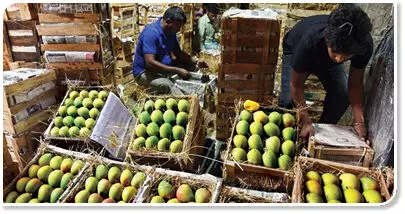Luscious mangoes of Ratnagiri
Renowned for its exquisite texture, taste, aroma, early bearing, and excellent keeping quality, the Alphonso — King of Mangoes — is unique to Konkan and carries the influence of weather parameters of the region

Mangifera Indica’ was introduced to the Konkan region by Afonso de Albuquerque, the Portuguese Viceroy in India from 1509 to 1515. This most popular mango variety is known as Alphonso in English, Hapus in Marathi, and Aphoos in Konkani. Over time, it has spread throughout the entire coastal tract of the Konkan region and is now cultivated in nearly 200,000 hectares across the five districts of Ratnagiri, Sindhudurg, Palghar, Thane, and Raigad. Renowned for its exquisite texture, taste, aroma, early bearing, and excellent keeping quality, it is regarded as the most delicious variety of mango. It thrives along the seashore in well-drained lateritic soils with a PH value ranging from 6.5 to 7.
This mango was granted the Geographical Indication (GI) tag in 2020 when the four applicants, namely the Director of Research, Dr. Balasaheb Sawant Konkan Krishi Vidyapeeth, Ratnagiri; Devgad Taluka Amba Utpadak Sahakari Sanstha Maryadit, Sindhudurg; Kelshi Parisar Amba Utpadak Sahakari Sangha Maryadit, Ratnagiri; and the Konkan Hapus Amba Utpadak Ani Utpadak Vikrete Sahakari Sanstha, agreed to merge their applications. This decision was based on the fact that the mango had a common geography and origin – and more importantly, a shared vision for this unique commodity.
In the application made to the GI office, the Director of Research submitted, “the colour of the fruit is attractive orange yellow; the pulp is firm but melting, fibreless, texture soft, flavour pleasant and tastes very sweet. It has an attractive red blush towards the basal end, which is typical of this fruit from the Konkan region and not in other areas.” This delicious and juicy mango with pleasant flavour and fragrance has long been one of the world’s most popular fruits. The luscious fruit is loved for its wonderful colour, wholesome fragrance, and irresistible taste.
The first flush of Alphonso, often referred to as the King of Mangoes, appears in October-November, accounting for around 15-20 per cent of the crop. The second wave arrives towards the end of November and lasts for a month, contributing another 30-35 per cent of the fruit. The third and final flush occurs from mid-January to the second half of February, resulting in the maximum fruit set and yield. A typical Alphonso tree starts bearing fruit at the age of five and can continue to do so for another five to six decades before reaching senility. Therefore, it is a highly valuable crop and falls under the definition of High-Value Agriculture (HVA).
As readers are aware, the Alphonso mango is prized in both domestic and international markets for its exceptional taste, fragrance, and vibrant colour. It is exported to various countries, including Japan, Korea, Europe, the USA, and West Asia. Additionally, new markets such as Australia and Canada have shown great potential.
Your columnist was the Joint Secretary in the Government of India, overseeing the National Horticulture Mission, known as the MIDH at that time, and was also responsible for international cooperation in agriculture, when the European Union imposed a ban on the import of this variety in 2014 due to the discovery of “non-European fruit flies” in some consignments, which was regarded as a significant threat to UK salad crops. However, through close cooperation between APEDA, the Maharashtra State Horticulture Mission, producer cooperatives, and exporters, the entire value chain for mango exportation was rationalised. Protocols for tracking and traceability were established, extending all the way to the farmer’s field. After the EU experts saw the progress made on the ground, the restriction was lifted within one production cycle. This exercise has continued to pay dividends for the Maharashtra government, which is now in a position to provide the GI tag to over four million individual pieces of Alphonso which constitute 95 per cent of all the mango production in the Konkan region. This has yielded immediate results, with organizations like KisanKonnect, an online farm-to-doorstep supplier, offering GI-tagged Alphonso mangoes directly from the farm. Thus, the buyer comes to know about the point of origin of the mango, the exact location of the orchard, and other details which gives a real sense of confidence to the consumer, even as it raises the income for the producer, the processor and everyone in the value chain — a virtuous cycle with positive outcome for all stakeholders.
Once ripened, the Alphonso mango’s skin changes to a thin, orange-yellow colour. It displays an attractive red blush towards the basal end, a distinctive characteristic of this fruit from the Konkan region that sets it apart from other areas. The fruit’s colour is attractive orange-yellow, with firm but melting pulp that is fibreless, soft in texture, and pleasant in flavour, offering a sweet taste.
The Konkan region receives an annual rainfall of 3000 mm, with a maximum temperature ranging from 30 to 34 degrees Celsius and a minimum temperature of 17 to 23 degrees Celsius. The humidity levels in this region typically range from 70 per cent to 95 per cent. These weather parameters significantly influence the quality of Alphonso mangoes produced in the region, which covers a plantation area of 1,84,000 hectares. The Alphonso mango has been listed in the GI Journal No. 106 on June 01, 2018.
The writer superannuated as the Director of the LBSNAA after 36 years in the IAS, and is currently a historian and policy analyst.



